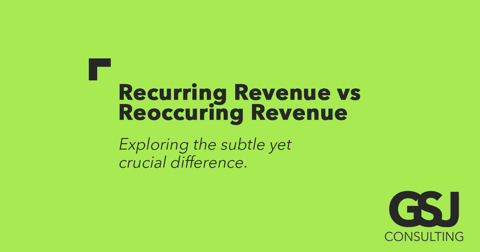Understanding the difference between a recurring and reoccurring revenue model

TIP: One is the Holy Grail for professional services firms, while the other can be a massive distraction.
Let’s take a look.
Recurring revenue
‘Recurring revenue’ = revenue that is expected to continue on a regular basis with a high degree of predictability.
Reoccurring revenue
'Reoccurring revenue’ = revenue that is repeatable, but not necessarily on a regular or predictable basis.
The difference from a pricing perspective
-
‘Recurring revenue’ is where professional services firms need to get to if they want revenue certainty – including the ability to earn money while they are sleeping.
-
‘Reoccurring revenue’ is where most professional services firms are at the moment.
More broadly, recurring revenue is generated when customers/clients make repeat purchases of your service on a regular basis that automatically renews. In essence, they are locked in, typically by contract, but can be otherwise. A leading example of a recurring revenue pricing model is subscription-based pricing. But there are other examples, such as membership-based pricing.
Reoccurring revenue can also mean repeat revenue from a single customer, but here, there is no predictability that you will get repeat work. In other words, there is no lock-in provision. So, transactional work, for example, can be reoccurring revenue but would not be considered recurring revenue.
So, isn’t recurring revenue just basically retainers?
No. Retainers are often mistaken for being recurring revenue when what they are is reoccurring revenue.
That said, it is easy to understand the confusion.
When considering this, what you need to ask yourself is:
“Does my retainer automatically renew?”
If so, then you have a subscription-based recurring revenue model. If not, then you have a reoccurring revenue model at best - as the client can just walk away at any point.
Why does this even matter?
While recurring revenue and reoccurring revenue might sound the same, there is actually a very important structural distinction.
Recurring revenue allows you to budget for a stable and consistent income over time. Your primary concern with this pricing/revenue structure is churn - when customers leave you. Provide a great service, and this should be less of an issue.
Reoccurring revenue, on the other hand, lacks predictability. It is inconsistent. Your primary concern is no longer whether your client will leave you but whether they will come back to you at all or go to your competition! So, not only do you need to provide a great service, but you also have to hope they come back.
Understanding this distinction is important because…
If your strategy is to create a predictable income stream, you need to be focused on recurring revenue over reoccurring revenue.
If you want loyal customers, then having a recurring pricing structure in place will provide you with higher customer lifetime value.
Why?
Because the reoccurring revenue model requires higher costs to maintain customer engagement - you need to win the deal every day/week/month.
This is all too hard - need help?
Understanding the difference between recurring revenue and reoccurring revenue structures is key to building your business and developing the relationships you have with your customers/clients. The nuances between the two can be difficult to understand, so feel free to get in touch if you want to talk this through.
Last but not least, if you are a law firm partner looking to earn money while you sleep, you need to implement a recurring revenue pricing model!
Contact GSJ Consulting
We can help you Aquire, Retain, Grow
The information contained in this article is of general nature and should not be construed as professional advice. If you require further information, advice or assistance for your specific circumstances, please contact us.
